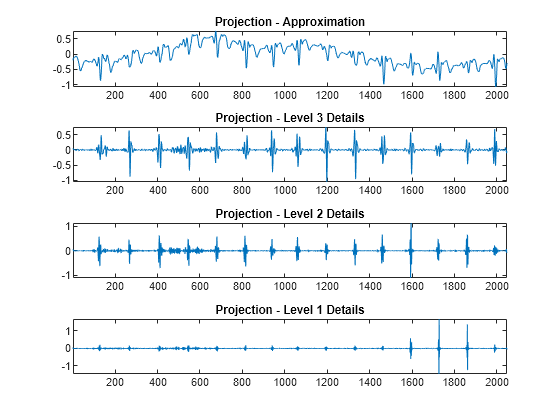lwtcoef
Extract or reconstruct 1-D LWT wavelet coefficients and orthogonal projections
Since R2021a
Description
y = lwtcoef(ca,cd,Name,Value)y =
lwtcoef(ca,cd,'OutputType','coefficients') specifies coefficients
output.
Examples
Load a 1-D signal of length 2048. Plot the signal.
load wecg plot(wecg) title('Signal') ylabel('Amplitude') axis tight

Create a lifting scheme associated with the db4 wavelet. Use the lifting scheme to obtain the wavelet decomposition of the signal to the maximum level. Confirm the length of the detail coefficients cell array equals floor(log2(N)), where N is the length of the signal.
wv = 'db4'; lsc = liftingScheme('Wavelet',wv); [ca,cd] = lwt(wecg,'LiftingScheme',lsc); [length(cd) floor(log2(length(wecg)))]
ans = 1×2
11 11
Extract and plot the approximation coefficients at level 3. Confirm the length of the extraction is one-eighth the length of the original signal.
approxCf = lwtcoef(ca,cd,'LiftingScheme',lsc, ... 'OutputType','coefficients', ... 'Level',3); [2048/(2^3) length(approxCf)]
ans = 1×2
256 256
plot(approxCf) title('Level 3 Approximation Coefficients') ylabel('Amplitude') axis tight

Obtain the orthogonal projection of the level 3 approximation coefficients. Also obtain the orthogonal projections of the detail coefficients at levels 1, 2, and 3. Plot the results.
approx3 = lwtcoef(ca,cd,'LiftingScheme',lsc, ... 'OutputType','projection','Level',3); det3 = lwtcoef(ca,cd,'LiftingScheme',lsc, ... 'OutputType','projection','Level',3,'Type','detail'); det2 = lwtcoef(ca,cd,'LiftingScheme',lsc, ... 'OutputType','projection','Level',2,'Type','detail'); det1 = lwtcoef(ca,cd,'LiftingScheme',lsc, ... 'OutputType','projection','Level',1,'Type','detail'); tiledlayout(4,1) nexttile plot(approx3) title('Projection - Approximation') axis tight nexttile plot(det3) title('Projection - Level 3 Details') axis tight nexttile plot(det2) title('Projection - Level 2 Details') axis tight nexttile plot(det1) title('Projection - Level 1 Details') axis tight

Confirm the sum of the four projections equals the original signal.
max(abs(wecg-(approx3+det3+det2+det1)))
ans = 1.3323e-15
Input Arguments
Approximation (lowpass) coefficients at the coarsest level, specified as a
scalar, vector, or matrix. The coefficients are the output of lwt.
Data Types: single | double
Complex Number Support: Yes
Detail coefficients, specified as an L-by-1 cell array,
where L is the level of the transform. The elements of
cd are in order of decreasing resolution. The
coefficients are the output of lwt.
Data Types: single | double
Complex Number Support: Yes
Name-Value Arguments
Specify optional pairs of arguments as
Name1=Value1,...,NameN=ValueN, where Name is
the argument name and Value is the corresponding value.
Name-value arguments must appear after other arguments, but the order of the
pairs does not matter.
Before R2021a, use commas to separate each name and value, and enclose
Name in quotes.
Example: y =
lwtcoef(ca,cd,'LiftingScheme',lsc,'OutputType','coefficients','Level',2)
uses the lifting scheme lsc to extract the approximation
coefficients at level 2.
Orthogonal or biorthogonal wavelet, specified as a character vector or
string scalar. See the Wavelet property of liftingScheme for
the list of supported wavelets. For perfect reconstruction, the
specified wavelet must match the wavelet you used to generate
ca and cd.
You cannot specify 'Wavelet' and
'LiftingScheme' name-value arguments at the same
time.
Lifting scheme to use, specified as a liftingScheme object. For perfect reconstruction, the
specified lifting scheme must match the lifting scheme you used to
generate ca and cd.
You cannot specify 'Wavelet' and
'LiftingScheme' name-value arguments at the same
time.
Output type, specified as one of:
'coefficients'— Extract the approximation or details coefficients'projection'— Return the projection (reconstruction) of the approximation or details coefficients
Example: y =
lwtcoef(ca,cd,'OutputType','projection','Type','detail')
returns the projection corresponding to the detail coefficients at the
finest scale.
Type of coefficients to extract or reconstruct, specified as
'approximation' or
'detail'.
Example: y = lwtcoef(ca,cd,'Type','detail') extracts
the detail coefficients at the finest scale.
Level of coefficients to extract or reconstruct, specified as an
integer in the range [1,N], where
N is the length of
cd.
Example: y =
lwtcoef(ca,cd,'LiftingScheme',lsc,'Level',3) uses the
lifting scheme lsc to extract the approximation
coefficients at level 3.
Data Types: double
Extension mode to use to extract or reconstruct the coefficients, specified as one of these:
"periodic"— Periodized extension"zeropad"— Zero padding"symmetric"— Symmetric extension
This argument specifies how to extend the signal at the
boundaries. The extension mode must match the value you used to generate
ca and cd.
Example: y = lwtcoef(ca,cd,Extension="zeropad")
specifies zero padding.
Output Arguments
Extracted coefficients or projection, returned as a vector or matrix. If
ca is a scalar or vector, and the elements of
cd are vectors, then y is a
vector. If ca and the elements of
cd are matrices, then y is a
matrix, where each column is the extraction or projection of the
corresponding columns in ca and
cd.
Data Types: single | double
Extended Capabilities
C/C++ Code Generation
Generate C and C++ code using MATLAB® Coder™.
Version History
Introduced in R2021aThe lwtcoef input syntax has changed. Use name-value
arguments instead.
| Functionality | Result | Use Instead | Compatibility Considerations |
|---|---|---|---|
Y =
lwtcoef(TYPE,XDEC,LS,LEVEL,LEVEXT) | Errors |
| According to the value of
|
See Also
lwt | ilwt | liftingScheme
MATLAB Command
You clicked a link that corresponds to this MATLAB command:
Run the command by entering it in the MATLAB Command Window. Web browsers do not support MATLAB commands.
选择网站
选择网站以获取翻译的可用内容,以及查看当地活动和优惠。根据您的位置,我们建议您选择:。
您也可以从以下列表中选择网站:
如何获得最佳网站性能
选择中国网站(中文或英文)以获得最佳网站性能。其他 MathWorks 国家/地区网站并未针对您所在位置的访问进行优化。
美洲
- América Latina (Español)
- Canada (English)
- United States (English)
欧洲
- Belgium (English)
- Denmark (English)
- Deutschland (Deutsch)
- España (Español)
- Finland (English)
- France (Français)
- Ireland (English)
- Italia (Italiano)
- Luxembourg (English)
- Netherlands (English)
- Norway (English)
- Österreich (Deutsch)
- Portugal (English)
- Sweden (English)
- Switzerland
- United Kingdom (English)